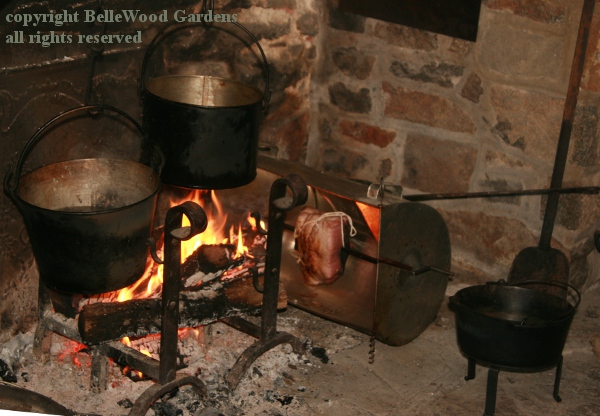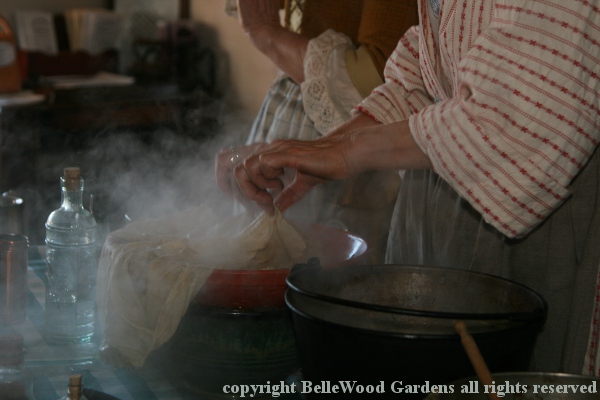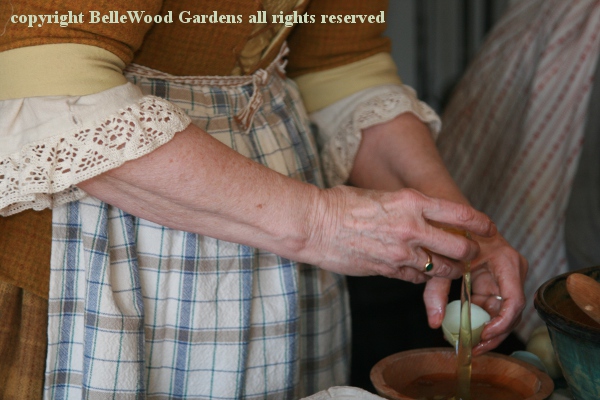
.
If you have any comments, observations, or questions about what you read here, remember you can always Contact Me
All content included on this site such as text, graphics and images is protected by U.S and international copyright law.
The compilation of all content on this site is the exclusive property of the site copyright holder.
This afternoon I'm off for a visit to Bouman Stickney Farmstead Museum in Readington Township, New Jersey, for another of their open hearth cooking events. Today it will be Connie Unangst and Bev Altrath preparing multiple dishes that would have been made in late winter. Keep in mind that back in the 18th century in winter there would be no strawberries, lettuce, broccoli to be shipped in from California. It would be a matter of root vegetables such as potatoes and turnips, some onions, lacto-fermented cabbage become sauerkraut, some apples kept separate from the vegetables and stored away in a root cellar. It will be interesting to see what they'll be making.

Bev and Connie are already at work when I get there
shortly after the 1:00 p.m. start time.

Good fire in the hearth and a pork roast in the reflector oven.

There are some pickles (preserved food, yes) that will be chopped
and added to other ingredients to make a sauce for the pork.
The little piece of pickle I sampled tasted pretty good on its own.

They're making a steamed dumpling type thing. Peel, cut, and stew the apples. Butter and flour a pudding cloth. Line it with puff pastry, which is fancier than a basic lard / flour dough. Add the stewed apples. Gather up the sizable cloth making sure corners and sides are all tucked together. Twist the fabric together and tie up.

Tie the string to the upper hook from which the pot is hanging
and then lower the dumpling into the pot of boiling water.
And let it cook.

Hoick it out when done and open carefully. It's steaming hot!

Starting on another dish, Connie is peeling potatoes with a paring knife.
Understand, since everything takes a lot of time
several things are going on simultaneously.

This hearty pie has layers of potatoes, then onions, some apple,
hard boiled eggs, and repeat with whatever you have more of.

This is blade mace, the threadlike outer covering of a nutmeg.
Some will be ground in a mortar, added to some grated nutmeg

and together they'll be sprinkled over the pie.

The bottom pastry crust pastry is firmly crimped together with
the top crust, which is then slashed to release the steam.

Connie shovels some glowing red coals to a fresh location on the hearth, making a new "burner." She then sets a lidded Dutch oven on its short legs over the coals to preheat. The pie is lowered into the oven. More hot coals are piled on top, held in place by the low rim of the lid.

And how nicely browned it comes out of the oven when done.

One more dish is under way. Bev is separating eggs
to be used for German puffs.
Receipt To make German Puffs.
Put half a Pint of good Milk into a Toffing Pan, and dredge in Flour 'till it is as thick as hafty Pudding, keep ftirring it over a flow Fire 'till it is all of a Lump, then put it in a Marble Mortar, when it is cold put to it the Yolks of eight Eggs, four Ounces of Sugar, a Spoonful of Rofe Water, grater a little Nutmeg, and the rind of half a Lemon, beat them together an Hour or more, when it looks light, and bright, drop them into a Pan of boiling Lard, with a Tea Spoon, the size of a large Nutmeg, they will rife and look like a large yellow Plumb if they are well beat: As you fry them, lay them on a Sieve to drain, grater Sugar round your difh, and ferve them up with Sack for Sauce. It is a proper Corner Difh for Dinner or Supper.

Very nice indeed.
It is interesting how many countries have fried dough in their cuisine.
Donuts, beignet, churro, fry bread, hush puppies, oliebollen.
Plain or fancy. Filled or not. With jam. Sugar dusted. Popular.
Back to Top
Back to March 2017
Back to the main Diary Page